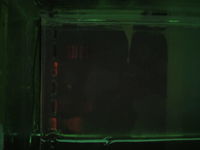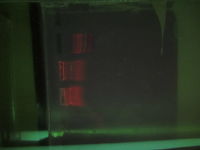Difference between revisions of "Project:Sex typing with amelogenin/results-20120301"
m (→Experiment 1) |
(Added a bit about oils) |
||
| Line 5: | Line 5: | ||
== Experiment 1 == | == Experiment 1 == | ||
Visualised the previous night's PCR run on 1% agarose gel with 10ul/100ml ethidium bromide stock solution. This is twice the amount of EtBr as usual, but it doesn't make a difference (see below). | Visualised the previous night's PCR run on 1% agarose gel with 10ul/100ml ethidium bromide stock solution. This is twice the amount of EtBr as usual, but it doesn't make a difference (see below). | ||
| + | |||
| + | We did not cover the master mix / primers / template solution with oil. The PCR reaction vessels had condensed liquid all over the vessel, including up near the lid. I (Nicholas) theorise that the mixture evaporated, inhibiting PCR, in some cases severely. | ||
[[File:2012-02-29-results-1.JPG|200px|thumb|none|Results of experiment 1 (Empty lane, ladder, Nicholas, Helena, Mike, Tonderai)]] | [[File:2012-02-29-results-1.JPG|200px|thumb|none|Results of experiment 1 (Empty lane, ladder, Nicholas, Helena, Mike, Tonderai)]] | ||
| Line 18: | Line 20: | ||
* Ensure the alcohol was mixed with the tenderiser solution, in order to precipitate out the most DNA | * Ensure the alcohol was mixed with the tenderiser solution, in order to precipitate out the most DNA | ||
* Ensure that the DNA, when extracted from the alcohol / saliva / tenderiser solution (yuck), was well dried, by heating for 5 min at 55 degrees. | * Ensure that the DNA, when extracted from the alcohol / saliva / tenderiser solution (yuck), was well dried, by heating for 5 min at 55 degrees. | ||
| + | |||
| + | I tried two different oils: | ||
| + | * "Laser Lube" (Thanks to Hipster for this description) -- machine lubricant, from a can near the drill press | ||
| + | * A mysterious bottle of oil I found in the biohacking box, which could be mineral oil (though it's not the same bottle that we were using before). | ||
I used the old master mix, as we have run out of the new stuff. | I used the old master mix, as we have run out of the new stuff. | ||
| Line 23: | Line 29: | ||
Visualised on 1% agarose gel with 6ul/100ml ethidium bromide solution. NB we have previously been using 5ul/100ml. Based on these results I am not convinced that more EtBr is at all helpful -- I noticed no difference in brightness between these two runs. | Visualised on 1% agarose gel with 6ul/100ml ethidium bromide solution. NB we have previously been using 5ul/100ml. Based on these results I am not convinced that more EtBr is at all helpful -- I noticed no difference in brightness between these two runs. | ||
| − | [[File:2012-03-01-results-1.JPG|200px|thumb|none|Results of experiment 1 (Empty lane, ladder, Nicholas - meat tenderiser, Nicholas - meat tenderiser, Nicholas - heat to lyse)]] | + | [[File:2012-03-01-results-1.JPG|200px|thumb|none|Results of experiment 1 (Empty lane, ladder, Nicholas - meat tenderiser and laser lube, Nicholas - meat tenderiser and mystery oil, Nicholas - heat to lyse and mystery oil)]] |
Once again, two distinct bands are visible, but they don't seem to be in the right places on the gel. | Once again, two distinct bands are visible, but they don't seem to be in the right places on the gel. | ||
| + | |||
| + | I conclude that we can use either mystery oil or laser lube. | ||
This is looking much more promising. It seems that it will now be a matter of fine tuning. | This is looking much more promising. It seems that it will now be a matter of fine tuning. | ||
Also, the orange filter is amazing! Thanks to Stu. | Also, the orange filter is amazing! Thanks to Stu. | ||
Revision as of 21:32, 2 March 2012
More photos of these results are available here: [[1]]
The descriptions below refer to gel lanes from the top downwards. Sorry, Rafael, but I didn't bother to rotate them this time :|
Experiment 1
Visualised the previous night's PCR run on 1% agarose gel with 10ul/100ml ethidium bromide stock solution. This is twice the amount of EtBr as usual, but it doesn't make a difference (see below).
We did not cover the master mix / primers / template solution with oil. The PCR reaction vessels had condensed liquid all over the vessel, including up near the lid. I (Nicholas) theorise that the mixture evaporated, inhibiting PCR, in some cases severely.
It is hard to see, but it almost looks like lane 4 (Tonderai? Or was it Mike?) is almost right -- there seem to be two distinct bands.
Experiment 2
Nicholas ran another experiment during the day on March 1.
The protocol was as usual (see previous 4 or so notes), using the meat tenderiser method. He was careful to:
- Ensure the meat tenderiser / saliva solution was well mixed, with a 1-2 minute "sitting time" for the enzyme to take effect
- Ensure the alcohol was mixed with the tenderiser solution, in order to precipitate out the most DNA
- Ensure that the DNA, when extracted from the alcohol / saliva / tenderiser solution (yuck), was well dried, by heating for 5 min at 55 degrees.
I tried two different oils:
- "Laser Lube" (Thanks to Hipster for this description) -- machine lubricant, from a can near the drill press
- A mysterious bottle of oil I found in the biohacking box, which could be mineral oil (though it's not the same bottle that we were using before).
I used the old master mix, as we have run out of the new stuff.
Visualised on 1% agarose gel with 6ul/100ml ethidium bromide solution. NB we have previously been using 5ul/100ml. Based on these results I am not convinced that more EtBr is at all helpful -- I noticed no difference in brightness between these two runs.
Once again, two distinct bands are visible, but they don't seem to be in the right places on the gel.
I conclude that we can use either mystery oil or laser lube.
This is looking much more promising. It seems that it will now be a matter of fine tuning.
Also, the orange filter is amazing! Thanks to Stu.

